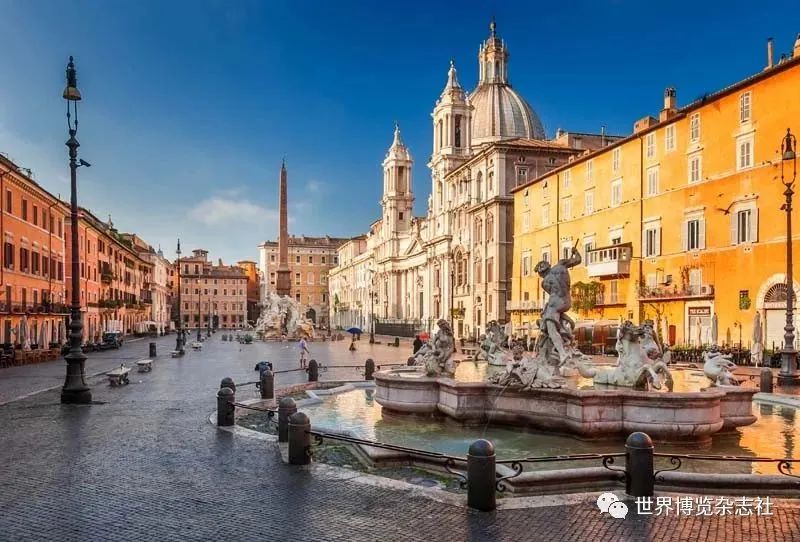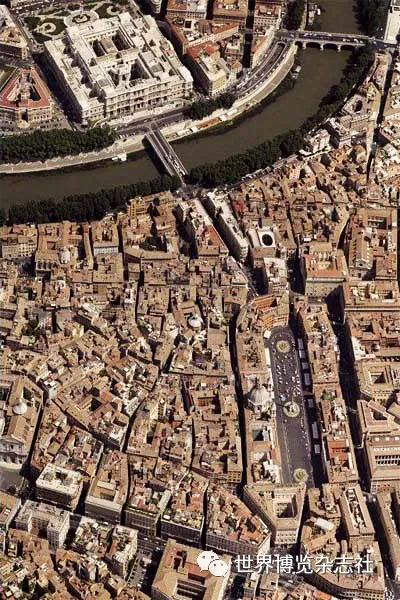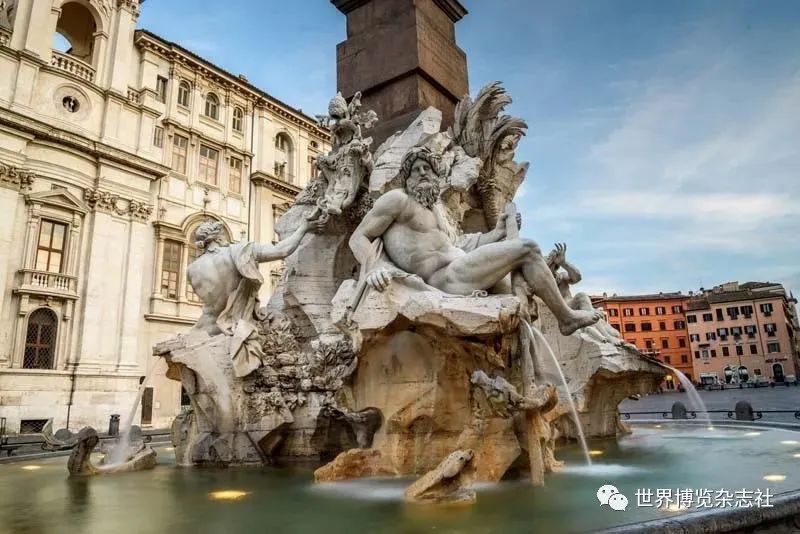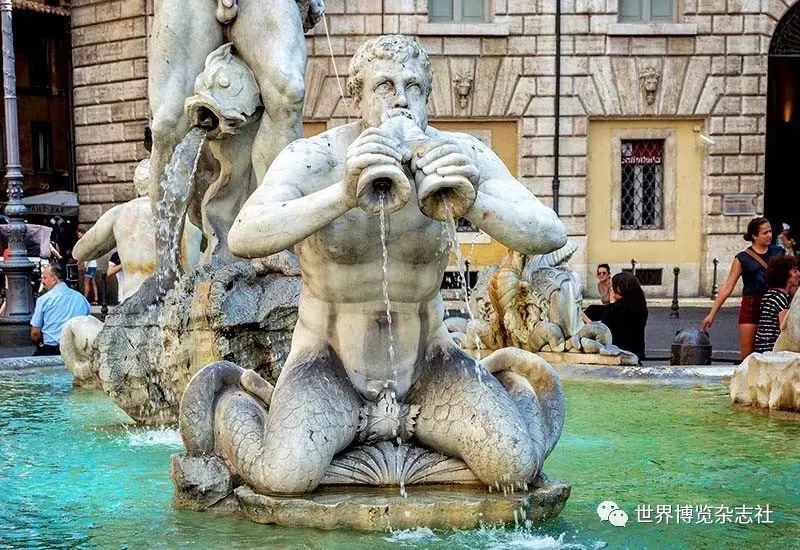Navana Plaza: broken from the ruins into a cocoon into a butterfly
Author:Knowledge Society Time:2022.08.30
The blue and bright sky, the colorful houses, the gorgeous palace and the solemn church, the magnificent and vivid fountains, coupled with the endless tourists, the coffee shop and a variety of souvenirs ... Waner Square is the most beautiful square in Rome -shocking but kind and pleasant, and the beauty of classical and life is perfectly integrated here.
This strange square square was built on the ancient Roman Arena two thousand years ago, and the shape of the horseshoe was taken. Its original name was "Agone", Latin's "competitive". In 85 AD, the last Emperor Domiziano of the Flavi dynasty built a arena specializing in track and field competitions and entertainment activities, and witnessed the transfer of the years.

Navava Square is the most beautiful square in Rome -shocking but kind and pleasant, and the beauty of classical and life is perfectly integrated here.
Tumi Shan Arena's former lively scene
The most famous arena in the world is the Colosseum, but few people know that the Tumi Shan Arena, which was built at the same time as the beast field, was also loved by the ancient Romans. The reason is very simple. The Tumi Shan Arena has been buried underground and hidden behind a well -known world -Navavana Square.
Let's go back to ancient Rome in the 1st century AD. The Augustus dynasty ended with the death of Nero. After the short -term troubled times, the Flavi dynasty appeared on the stage -after his father Vespa Township and his brother Titus, his father, Titus, and his elder brother Tatus. And the year of standing is the throne of the emperor. The built beast field built by the dynasty was also officially completed in the Tu Mishan era, and the bloody stimulating corner fighter performance appeared on the historical stage. At the same time, Tu Mishan also determined the formal festival of sacrifice sacrifice. In this festival, music, sports and equestrian performances must be held, and literary and music competitions must be played in the Greek method. Sports competitions and cultural performances alternately to enjoy the highest gods, and it also satisfies the personal hobbies of Tu Mishan as the followers of ancient Greek culture.
In order to give these activities a more appropriate place to host, Tu Mishan decided to build a arena and a concert hall. These two buildings are typical Greek style and are located in the center of God of War.
In the ancient Roman era, track and field movements have never been favored by the public like a horned fighter or animal hunting, and even the chariot competition. In the concept of the Romans, physical fitness is used to fight or for public engineering, and track and field is completely for the beauty of the body. The lack of fierce confrontation and bloody scenes is not attractive. Only the Emperor Tumi Shan, through the construction of this arena, successfully provided Rome with a long -lasting track and field competition, and gradually conquered the Romans with original performances and spectacular scenes.
Among the many sports, wrestling movements are the most ornamental, and they are born to formally compliance with the public's favorite double duel competition. At that time, the wrestling movement allowed athletes to use boxing, head -collision, bite, dislocated the other party, provoked and suffocated, but did not allow damage to the eyes and the death of the other party. Similar boxing competitions are also welcomed by the public, but the athletes do not grades according to weight, only the difference between age. During the game, boxers can use a gloves made of cowhide, covering hands or arms. The boxers can attack the opposition, so the sign of an excellent boxer is that there are no scars on their faces.
At that time, the long jump competition was very similar to today, but the strange thing is that two cylindrical dumbbells made of stones or lead during jumping process ranged from 2-4 kg. , Thus jump further. During the running competition, the athletes were naked, and even did not wear shoes, and performed on a soil road surrounded by a fence. Tu Mihan even allows women to participate in the competition. The most difficult running competition is called "reinstalled infantry race". Players should wear helmets and shields to participate in the competition.
In addition to track and field competitions, influenced by the Intrus and Greek world, Rome has been a public performance and celebration called "Ludi" since ancient times, combining religious and sports factors. With the expansion of the empire territory and the accumulation of national wealth, celebrating the birthday, coronation ceremony, triumph war, and sacrifice gods must be held. In the bathing and bathing, a scene of great enjoyment, decaying and degeneration shrouded Rome.
According to the concept of Tu Mi and Shan, in the grand opening ceremony, the emperor himself must attend the presence of the people's cheers and announced that the festival officially started. Historian Surozius wrote in his "Biography of the Roman Emperor": "He (Tu Mi Shan) feet wearing sandals and Greek -style purple robes, wearing a top printed with Jupiter and Zhu The golden crown of the three main gods of the Mitnewa. The sacrifice surrounded him, wearing the same gorgeous robe, but the emperor's heroic posture was printed on the crown on his head. "
Tu Mishan is also keen on building a monument to build temples and meritorious ethics. In addition to holding various celebrations, he gradually turns his spearhead to the rich noble class, and often confiscates their property to supplement the treasury. In the last few years of ruling, Tu Mi Shan became very cruel and launched persecution against Jews and Christians, and even his own relatives did not let go. Due to the long -term enemy, Tu Mishan was soon stabbed by the Senate and was "recorded" by the Senate, carrying the notorious "tyrant". After the extravagant Flavi dynasty, the highly respected Nilva was elected as the emperor, and the more prosperous era of the Five Emperor Roman began. Navana Plaza is based on the Tumi Shan Arena, with horseshoe shape. The location of the buildings around the square today is the stand of the past areas, and the venue of the square is the past.


The gorgeous transformation of Navana Square
In the era of the empire, the Tumi Shan Arena has always been the center of the ancient Roman sports competition and festival celebration. After the Fighting Field fire in 217 AD, Tumi Shan Stadium was briefly used as the venue of the Fighter Fighter. Subsequently, another Roman Emperor Alexander Saisu fixed the arena. In the 4th century AD, historian Amamianus Marcarius also visited the Tumi Shan Arena personally and praised him for its magnificence.
According to the legend, before Christianity became the state religion, the arena is notorious for becoming a place to persecute Christians. After the Roman Empire was destroyed, the arena was abandoned. The Romans built their dwellings around them, retaining the shape of the ancient arena, and surrounded the ruins. Later, this stadium, like other ancient Roman sites, became a free quarry of public and private. Its masonry and pillars were filled in the newly -built houses and church foundations. As the height of the city has continued to rise in many centuries, the arena has gradually become a concave ground. The rainy season of August each year, the square becomes a disgusting swamp, and sometimes it needs to take a boat through. Perhaps in the rainy season of the ancient Roman glory, chaotic and disgusting, coupled with the influence of Roman dialects, "Agenon" was passed on to "Navavana", which means "big ship" Essence
According to limited text records, the arena site was the territory of the church in the 10-11 century. In the 13th century, the Roman people took advantage of the struggle with the Pope. It became the jurisdiction of Roman local administrators and was used as a place for performances and rally from time to time. Until the Renaissance, Navava Square was still the traditional knight practice venue and carnival performance venue. For example, in 1476, the family of Pope Sistech IV held a typical medieval shot -long shot competition. In addition, Navana Square was also one of the oldest farmers' markets in Rome, and was the most often patronized by Roman residents. However, as the square's reputation became more and more famous, the Pope decided to transfer the market to the nearby flower square, and only held Christmas markets here around Christmas.
From 1886 to 1889, during the road repair process on the north side of the square, the Romans discovered some dome and Ionian -style pillars of the ancient Roman arena at 3.5 meters underground. Nowadays, this part is included in the Museum Museum of Midtime, and tourists can overlook the sidewalk. Under the San Aiez Church in the Square of Navana today, the Simon site dedicated to the emperor in and out. And in the underground of each surrounding square building, you can find the arches of the arena. The most famous of Rome's "speaking sculpture "-" Pasquino "comes from the Tammishan Arena. At the beginning of the 16th century, a person signed "Pasquino" secretly posted a poem that was sharp and criticized on the statue of the statue, which caused an open "fighting poem": the poets invited this statue to replace instead of instead They spoke, saying that they dare not talk publicly. "Pasquino" has since become the name of the statue and has also been given a new mission: he understands current affairs and criticizes all people and things that others dare not talk about. Even though today's social networks have become very popular, Pasquino is still active between Romans. Today, "Pasquino" has been placed in the corner of Navana Square, becoming a place where modern Italians criticize current politics.
In 1644, after the Pope's Innocenzo X appeared on the historical stage, the Panfeli family was more than the noble families such as Barbarini and Farnesse: they were in their family palace The masterpiece of Navava Plaza, who wants to make it extremely gorgeous and crowns Rome. As a result, the ruins of the ancient Roman arena were fully planned into the new square, and several palaces and houses located in this years were quickly demolished. The Panfeli family appointed the most outstanding batch of artists at the time to rebuild the square, which was the Navavana Square, which is famous today.
Two genius fighting

With the rise of the Panfeli family, the former Pope and the Barbarini family's most popular artist Belnney were abandoned, and Bolomini, who had studied Bernini, was reused. When Bolomini, who was in full swing, did not hesitate to demolish the results of Belnney before. In addition, he even designed the fountain for Navana Square. The sister -in -law of Pope Benozo Tenth and the hostess of the Panfeli family, Donna Olympia Mendalcini, is the ultimate ruling of the artist. It is said that Bilnini secretly sent her the silver model of the Sihe fountain design, completely convinced the hostess so that she would transfer the fountain design to Belnney. The consensus between the two genius artists has become a topic of people in many centuries. The Sihe fountain designed and built by Belneni is located in the middle of Navana Square. The fountain sculpture depicts the four river gods: the Nile God of Africa, the Gange River God in Asia, the Danube River God in Europe, and South America from South America. The Laplata River God represents the world's Quartet. The four river gods have different movements, with strong metaphors. The central center of the sculpture has an enlarged manner from the ancient Egypt, and at the top of the appliance of the Founder is the symbol of the Panfeli family -a pigeon with olive branches. According to some legends, Belnney tried to use his own works to humiliate Bolomini: he let the Nile God of the Nile of the Church of Sheng Aenez cover his head, and to satire the design of Bolomini's design; he also let him make The Laplata River God stretched out his hands to protect, implying that the rough church was about to collapse.
The sculpture of the Sihe fountain in the middle of the square depicts four river gods.
However, through literature studies, the legend is unique. Because the text clearly records that the fountain was built in 1648-1651, and the church started construction in 1652, and the original designer was not Bolomini. On the other hand, there are even more convincing explanations by blinding the head of the Nile: the ancient Greeks and the ancient Romans have tried to find the source of the Nile River, but they have never been successful. It is depicted as a male god who covers his face with branches and leaves -this design is not the originality of Bernini.

The St. Aneus Church, which was designed by Bolomini, was close to the Panfeli family's palace and was originally built as a private church. In 1652, the master of architecture Gorolo Moramadi accepted the appointment and started to build a church, but the following year Bolomini took the task halfway, and he boldly modified the former design: increase the distance between the two towers, The front facade of the backward depression was also designed to make the dome of the church more prominent. In addition to the Church of St. Anez, Bolomini also participated in the construction of Panfeli Palace next to the church, leaving several exquisite designs in Rome. However, with the addition of another Pope Alexander VII, Belnney has become the darling of the Pope and his family, and Bolomini, who is tortured by health and mental illness, finally committed suicide in pain.
"Terry Tong" sculpture at the Moore Fountain at the southern end of the square.
In addition to the four river fountains, there are two cheerful and lively fountains in Navana Square. The southern end of the square is the Moore fountain. It depicts a scene where Moore and dolphins wrestle. There are 4 monsters "Terry Tong" around the fishtail. The fountain was originally completed by architect Polta in 1576. At that time, only dolphins and Terry were Tongtong; in 1653, Belnini designed a human image standing on the shell and grabbing a dolphin. In the end, another sculptor was completed according to the sketch. The northern end of the square is the place where the sea god fountain is built with the Moore fountain. In order to maintain consistency, the Roman government selected two artists through public bids in 1878, adding sculptures of the Haixian and giant squid, and also made it the name of "Poseidon Fountain".

After the war, Navana Plaza also became a place for street artists. They set up painting racks here, show and sell their works, or make portraits and comics for passers -by; others can play musical instruments, perform acrobatics, and sing high, so that this wide place is always full of vitality. On every day of the sun, thousands of tourists and residents came to Navana Plaza, not only to appreciate this unparalleled Baroque masterpiece, but also to experience the twists and turns history of more than 2,000 years. The most authentic sweet life of eternal city.
This article contains the 16th issue of "World Expo" magazine 2022
Editor in charge: ZAN
- END -
Danzhou Township, Wuling District is forbidden to burn, resist drought, and do not mistake the masses to relieve the people's concerns

The reporter Zeng Chuqiao, a correspondent of Changde Daily, has been on duty for ...
Building self -built houses Safety management Dam Sichuan Dazhou issued a number of measures
Cover news reporter Luo XuanIn order to deeply learn the lessons of the collapse of Changsha residents' self -built houses, and to build the dams of self -built houses in full, the dam was fully estab...